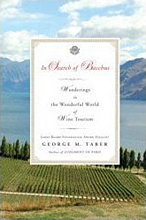You get a taste of both the high stakes of the wine business and the deep passions of its customers in the titles of George M. Taber’s books: Judgment of Paris: California vs. France and the Historic 1976 Paris Tasting that Revolutionized Wine and To Cork or Not to Cork: Tradition, Romance, Science and the Battle for the Wine Bottle. Now, Taber sends another dispatch from the vineyard that will entertain and educate, In Search of Bacchus: Wanderings in the Wonderful World of Wine Tourism.
In this book, Taber took on the task (someone had to do it) of visiting adozen of the most breathtakingly beautiful wine regions around the globe. What he came back with is a travel guide for oenophiles that also serves as a primer on how and why winemakers are increasingly turning themselves into destination sites. In addition, Taber’s tour opens a window on the growing segmentation of the travel industry as a whole and offers lessons about competitive advantage and marketing that apply to all consumer-driven businesses.
Knowledge at Wharton spoke recently with Taber about his latest book. An edited transcript of the conversation follows.
Knowledge at Wharton: What inspired you to write about wine tourism?
George M. Taber: It started when I was working on the cork book. I had two experiences within a three-week period. The first was when I was in the Douro Valley in northern Portugal and I was staying at a hotel that was associated with a winery at the top of the valley. When I travel, I have a terrible problem with jetlag. So I wake up very early in the morning and I go out and walk. And so I got up at 6 and it was a beautiful morning. I looked down on the valley and the Douro River below and the vines growing on the hillside. I thought this has got to be the most beautiful place in the world and the best example of wine tourism that there is.
About three weeks later, I was on the South Island of New Zealand and had a very similar experience — also at 6 in the morning. I was looking out at another winery and, again, it was just a stunningly beautiful place. I said, “No, no — the Douro Valley isn’t the most beautiful. This is the most beautiful.”
I came to the conclusion that wine isn’t made in ugly places. It is always made in one place more knockout beautiful than the last. And I was aware of the growing popularity of wine tourism. I thought somebody should put together a book that would give some of the history. Not a real guidebook, but more about what is happening in the industry. Who is doing what? What are the top regions?
Knowledge at Wharton: So if you look at it as a business, how do you think wine tourism compares with other kinds of tourism like ecotourism or adventure tourism?
Taber: They have a lot in common. They are the second or third — maybe even fourth — generation of tours for people. You used to make the big tour of Europe. Maybe you would go to Paris and have a Paris-specific tour. But now we are seeing more and more people doing tourism based on their interest — whatever their interest might be. It might be going on safaris in Africa. It might be cooking. It might be ecology. It might be to donate time to a nonprofit organization — I know a lot of people who take their vacations and work in nonprofits. So I think the tourism market is getting more sophisticated and it is probably splintering in a lot of ways like the media is splintering.
Knowledge at Wharton: What role does wine tourism play in the wine marketing business?
Taber: It is huge. Robert Mondavi was the founder of wine tourism. He started his winery out in California in the late 1960s and when he built it, it was with the idea of trying to attract tourists from San Francisco to come up to the Napa Valley. He placed his winery at the point on the main highway as close to San Francisco as he could get. So his winery was going to be the first one they saw when they got there. Napa has grown a lot since then. He is no longer the first. But he set the standard. And winemakers around the world all look to Mondavi as a model of best practices. They don’t always agree with everything he did, but the approach was very important. And one of the keys to Mondavi’s approach was education. In those days, you used to get a free wine tasting in the Napa Valley. Now they charge you a lot for the tasting. But Mondavi would give you the free tasting only if you first took a tour of his winery and saw how wine is made.
Knowledge at Wharton: You say in your book that, thanks to wine tourism, Napa Valley is now the second-most-popular destination in California, bringing five million people to the state each year.
Taber: The only tourist destination that is more popular — not surprisingly — is Disneyland. Some people might say that Napa is a bit like Disneyland for adults.
Knowledge at Wharton: The question, though, is what are some of the factors driving this? Why do five million people go to Napa every year?
Taber: I am not a psychiatrist. My answer may be a little soft on the edges. But there seems to be something that is almost in the human psyche that makes people like to go and experience the region where the wine was made. When I was researching the book, I talked with Francis Ford Coppola, the movie director. He owns two wineries — one in Napa and one in Sonoma County. He said that a visit is similar to a voter shaking hands with a politician — because you shake hands, you feel you have a certain bond. You may vote for that person just because you feel that bond. Coppola said that he was trying to create that same thing with his wineries.
Knowledge at Wharton: You traveled to 12 destinations in researching this book. How did you choose those 12?
Taber: I chose 11 of the 12 because I thought they were the most important wine-producing areas in their country. The 12th destination I will go into a bit later. But I first decided to pick a country and then to pick a region within that country. You could write a whole book about the business of wine tourism in France or Italy, it is just so widespread. But I felt that I wanted to give it a global scope. So, for example, in Italy I did just Tuscany. In the United States, I did just Napa. Bordeaux was the region for France.
I picked the 12th place, Georgia, because I was trying to throw a little curve ball into the book. I was intrigued with the story of Georgian wine. A University of Pennsylvania professor who is the foremost authority on the archaeology of wine is convinced that wine was first made in Georgia. I thought it would be interesting to go back, in effect, to the birthplace of wine and see what wine was like there. Also, I knew it was going to be an unusual country because it is a former Soviet republic. I was there just a couple of months before the Russian invasion. I thought Georgia would add an element that is somewhat unexpected and had that historic link.
Knowledge at Wharton: Just to go back to two regions that you mentioned — Tuscany and Bordeaux. How does wine tourism differ in those destinations? Or is it essentially the same?
Taber: It is very similar. Usually, there is a kind of process that all the wineries go through in developing tourism. First, they develop into a place to visit, which used to be very unusual. Fifty or 70 years ago, people didn’t visit wineries, which were basically just factories. So that is the first step. If the local rules allow it — and interestingly, Napa does not allow it — the second step is to associate a restaurant with the winery. Good food and good wine are just a natural mix, and the winery gets to show off its wares in the best possible light. The third step is to establish small hotels — almost bed and breakfasts. People love to stay overnight in a winery.
Those are the three starting points. But because wine tourism has become so popular, winemakers have to become more and more innovative. You have to have a gimmick — in a good sense. I visited a winery a few months ago in Virginia, for example, where the two owners — a husband and wife — are music graduates from the University of Miami. They are trying to combine wine and music by having concerts at the winery. They recommend their wines saying, “This wine will go very well with jazz. This wine will go with something else.” I’m not going to laugh at it — it is very important to differentiate yourself because competition has gotten tougher.
Knowledge at Wharton: Can you describe other examples of such innovation?
Taber: A winery in Texas has gotten into hosting outdoor concerts on Sunday nights. People come in and buy a bottle of wine. At first, they weren’t providing any food. But then they found a local restaurant that was willing to bring its truck around and now they sell food for those who don’t bring their own. Sometimes they get 1,000 people — it is very, very popular.
It is very important to realize from a business angle that the number of wineries has grown sharply over the last few years. They are just all over the place. Wine is now made in every state in the United States. A lot of these wineries are new ventures that would have difficulty surviving without tourism. I was talking to the leader of the New York Wine Industry Association and he told me that about 250 wineries are in the state and that probably only 50 would survive without wine tourism. The tourism is key because the producers can sell directly to the consumer who comes in off the street. That is especially important for the small wineries, which often have great difficulty getting into the regular distribution channels.
Knowledge at Wharton: Why are some areas more successful at wine tourism than others?
Taber: The beauty of the place, for one. That’s why Tuscany was my favorite of all the 12 places that I visited — it is knockout beautiful. The wine is excellent, the food is excellent, and you have friendly people. You have to have all those elements together. But at the same time, you have to be concerned that you don’t overdo it. You don’t want to have wall-to-wall people. Some critics of the Napa Valley development fear that is happening out there. You go up there on a fall Saturday or Sunday and it is just packed. It is bumper to bumper up and down the valley.
Knowledge at Wharton: In South Africa, you encountered a man by the name of Charles Back who makes a line of goat wines. Could you tell us about him?
Taber: Charles Back is the leader there. In each chapter, I tried to identify the leader or several leaders of the wine tourism movement. Sometimes there was just one person. Sometimes there were others. Sometimes it is the best winemaker. Sometimes it is not. Charles is a very creative guy. He studies other markets and what they are doing. He also has never met a pun he didn’t like. And, so, his line of wines bears names like Bored Doe. The French were quite unhappy with this. They took him to court a couple of times — so fa,r the courts haven’t ruled that a pun is illegal.
But this is another example [of the need to] differentiate yourself. You have to come up with something. Charles Back has differentiated himself with the names of his wines and the approach he has taken.
Knowledge at Wharton: You referred earlier to the fact that a number of people looked to Mondavi as the source of inspiration. How is Argentina trying to replicate the Napa Valley’s experience in its wine tourism business?
Taber: The first thing that Argentina had to do was improve the quality of its wines — until about 30 years ago, they were not up to standard. To learn more, a couple of wineries sent people to California, and a lot of them also sent some people to France. The one disadvantage that Argentina has is that the wine area is very spread out. That is a problem because many visitors want to visit four or five or six wineries in a day or two. Mendoza, which is the center of wine tourism in Argentina, unfortunately is spread out. But they are doing a very good job of stressing what is special about their region.
Knowledge at Wharton: Is wine tourism in Chile different from wine tourism in Argentina?
Taber: Wine tourism as such is very similar. What is different is that Chile and Argentina are concentrating on different wines. This is the innovation part that has to happen. Argentina is very famous for the Malbec grape, which is actually a French grape but the Argentines probably do a better job of growing it. They have the better climate for it and the better soil for it than the French. For its part, Chile has the Carmenere, which has a very similar story but is just a different style of wine. Both of them have added a Latin accent to their wine.
Knowledge at Wharton: Does wine tourism in New Zealand necessarily involve bungee jumping?
Taber: Not unless you are an author who has to try everything.
Knowledge at Wharton: Can you tell us that story?
Taber: In the book, in every chapter, in every country, I tried to have a personal experience. I was trying to make the book approachable to readers so that they could see through me what is happening in each area. So in Portugal, in the Douro Valley, I blended the wines the way a winemaker would do. At that winery, that is one of the things they do specifically to attract people to visit.
As for New Zealand, the Central Otago region in the South Island is the adventure capital of the world. It was in Central Otago that bungee jumping was invented. Everybody in Central Otago seems to be 21 years old, male and filled with adrenaline. So since it was the adventure capital and I was looking for what I used to call my first-person singular story, I thought, well, why don’t I do a bungee jump? I’m not a particularly adventuresome person. I’ve never skydived, for instance. But everybody in Central Otago bungee jumps and that made it a bit easier for me. Some people jump once a week. So, the question a lot of people have asked is how much wine did I have before I took the jump. The answer is, I was dead sober. It was 9:30 in the morning. I hadn’t had a drop.
Knowledge at Wharton: Of all the places you visited, do you have a personal favorite? And why?
Taber: As a wine tourism experience, I think it is Tuscany for the reasons I explained before. But the place that I have an emotional attachment to is Georgia. Partly because they have been isolated for so many years, the winemaking in Georgia is unlike winemaking in any other place in the world. Nobody makes it exactly the way they do, which is to take big earthen jars and bury them and make the wine right in those jars. They have two types of wine in Georgia. One they call traditional wine — that is, the 9,000-year-old way of making wine. And they do a Western wine as well.
Knowledge at Wharton: One last question. Where do you see wine tourism going?
Taber: It is going to grow and be more and more popular as people seek out new and interesting destinations and take specialized vacations like this. It has a tremendous future. For that reason, I have started a web site called Travel4Wine.com. What we are trying to do is create a community of people, certainly in the United States but also around the world, who are interested in wine tourism and will come to this site to share their experiences. They will be able to get information and do some studying before they go somewhere. And after they return, they can post their photos and start to think about their next trip.



